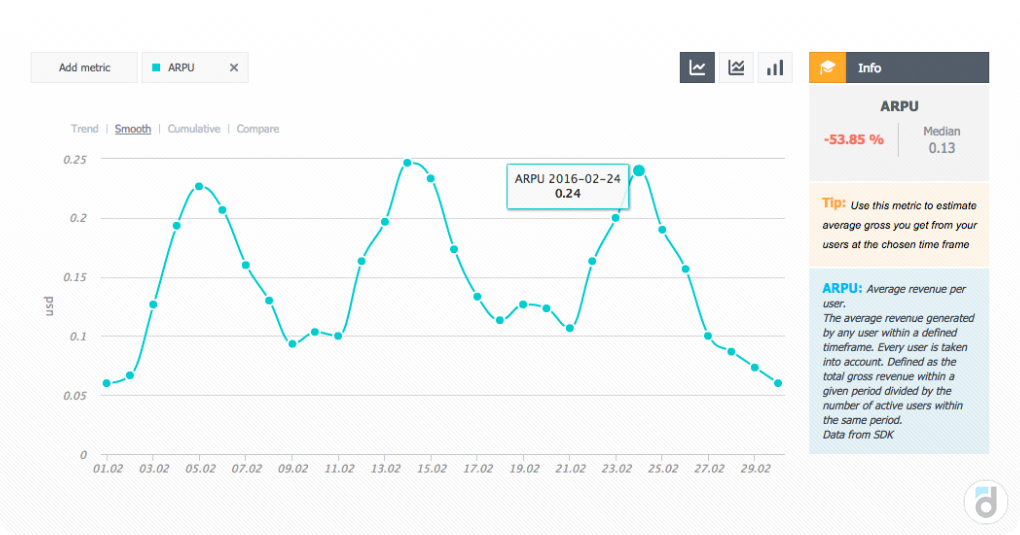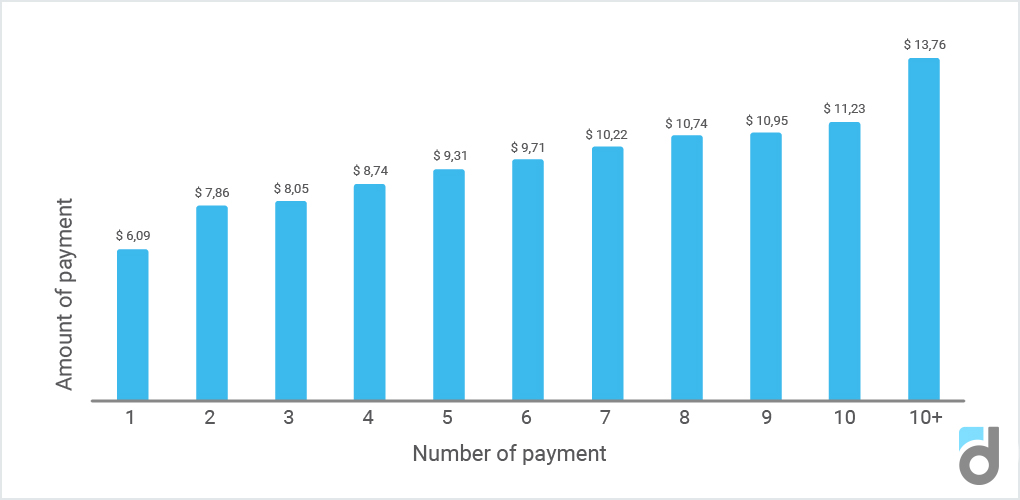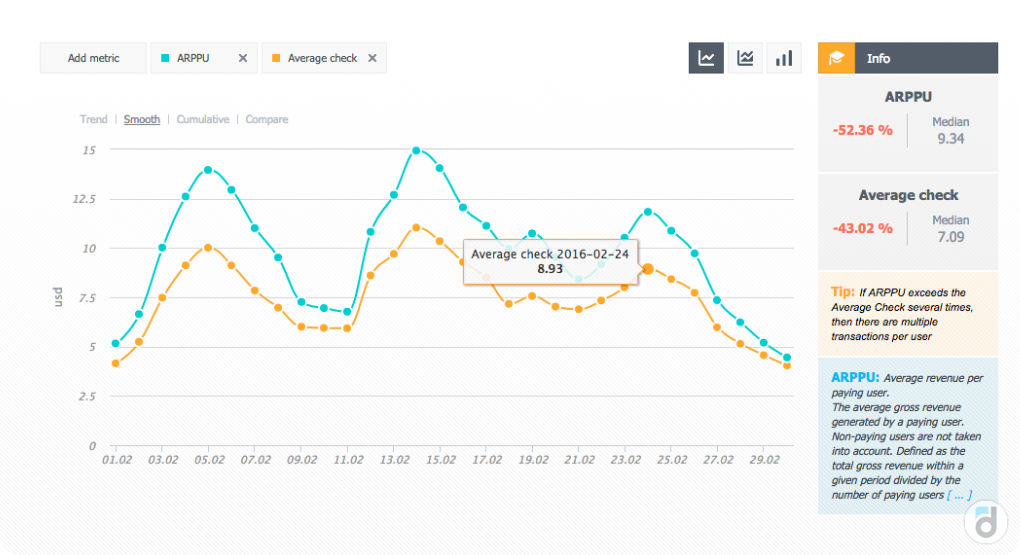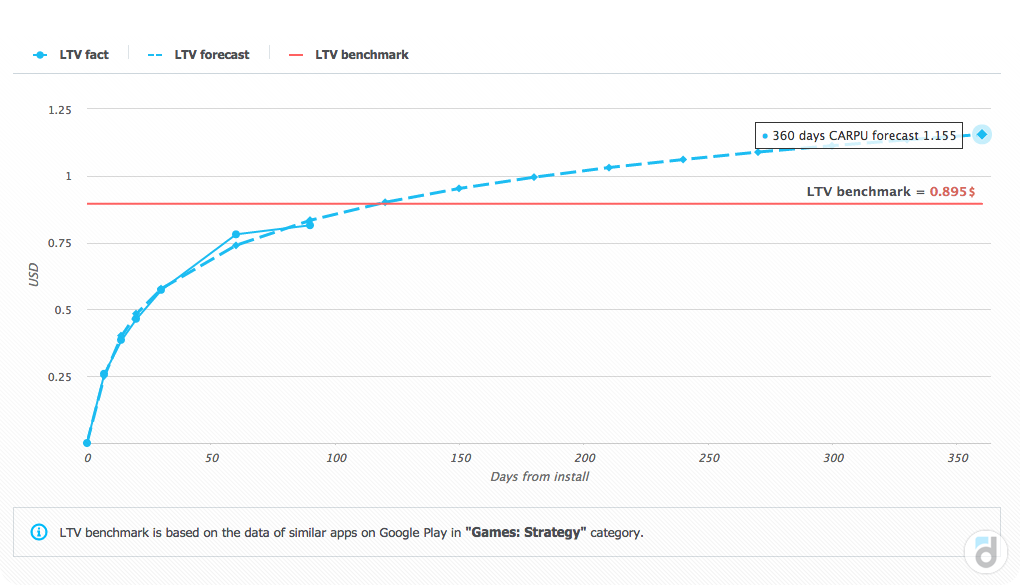We at devtodev are often get asked about the difference between ARPU and ARPPU and now we decided to answer this question once and for all. Also, we’ll explain a couple more metrics on the way.
So, ARPU is the Average Revenue Per User. This metric shows the average revenue per active user for the period. ARPU is calculated as the revenue divided by the active audience during the period of time: if calculated per day — divided by DAU (daily ARPU sometimes is also called ARPDAU), if calculated per month — divided by MAU.
ARPU = Revenue / Users
Please note that both paying and non-paying users are taken into account. Thus, ARPU is an indicator of the effectiveness of the project monetization: the higher it is, the more money one user brings during that period.

Read more: How to Integrate an Analytics System into your Game
ARPU can be used as the primary metric in the derivation of new changes (especially monetization) in the project: if the metric increases, then you did everything right.
ARPU also works well when comparing the performance of multiple projects. As a rule, the publisher chooses the project with a higher ARPU ceteris paribus.
Now let’s take a look at ARPPU. It differs by only one letter, but the differences are fundamental.
ARPPU means Average Revenue Per Paying User. The difference is that not all the users are taken into account but only those who made payments (i.e. only Paying Users).
ARPPU = Revenue / Paying Users
Thus, a smaller number of users is used in the denominator than in the calculation of ARPU. This means that ARPPU is usually significantly higher than ARPU.
When calculating ARPPU, it is also very important to be aware of the period you are analyzing metrics for: daily ARPPU and monthly ARPPU are completely different values. One user might make a few payments within a month and your daily ARPPU, in contrast to the monthly ARPPU, will not show them.
ARPPU is a reaction of paying users to the value of your project and it shows how much a loyal paying user is willing to pay. Also, this metric may be interpreted as the user reaction to the prices set in your project.
Note that if you increase prices, then your ARPPU is likely to rise along with the prices too. However, this does not mean that you’ll earn more, as the share of paying users will drop sharply. And here is the formula that links these two metrics:
ARPU = ARPPU * Paying Share
Let’s check the example below.
For example, you have 1,000 users, and 20 of them are paying users. Your total monthly revenue equals to $2,000. So, ARPU per month equals to $2,000/1,000 = $2 (one active user brings you an average of $2 per month).
At the same time, ARPPU will be equal to $2,000/20 = $100. I.e. one paying user brings you $100 per month.
The share of paying users (Paying Share) = 20/1,000 = 2%.
Finally, let’s check our equality: $2 = $100 * 2%
PROFIT!
Read more: Retention by Event Report - a Reliable Way to Measure User Loyalty
Interesting fact: we at devtodev analyzed a lot of payments made in online games, and our research shows that the more payments users make, the higher is the sum of their next payments.

First payments are usually a test because user wants to feel the benefits of the paid use. Then, if users like it, they gradually get a taste of it and begin to pay more and more.
-
the average size of the first payment is $6.09,
-
the average size of the eleventh and subsequent payments is already higher even more than twice, about $13.76.
Many also confuse ARPPU with the Average Check. The difference is not so critical, but it’s still there. As you know, ARPPU is calculated as the ratio of revenue to the number of paying users. Average Check takes into account only the number of transactions:
Average Check = Revenue / Transactions
If one paying user made repeated transaction in the period, the denominator in ARPPU would not change, but the number of transactions would increase, and this will affect the Average Check. Thus, the more repeated payments users make, the greater is the difference between ARPPU and Average Check. Although these figures are still connected and usually highly correlate:

Finally, let’s talk about another metric that is especially useful when calculating Lifetime Value and evaluating the quality of traffic. This is Cumulative ARPU.
Usually, when calculating ARPU, the entire audience and the entire revenue that it brings is taken into account. When calculating Cumulative ARPU, we look at the audience that came into the project at a certain period of time (for example, all users registered on March 1st). The calculation includes the revenue brought by these users, as well as the number of these users.
Cumulative ARPU N days = Revenue of selected segment for N Days / Audiences of selected segment
Cumulative ARPU is calculated for the certain periods of time: 1 day, 7 days, 14 days, 30 days and so on. For example, 7 Day Cumulative ARPU for 7 days shows how much money one average user brings in his first 7 days of stay in the project.
Read more: Analyze 3 Revenue Sources - Ads, In-apps and Subscriptions
This metric is a non-decreasing one and the more days pass from the date of the registration, the greater it becomes. If you buy a good-quality traffic, then sooner or later the moment occurs when Cumulative ARPU equals to CPI (Cost Per Install) and exceeds it. Remember this moment, as this is the payback point for your traffic.
Finally, when Cumulative ARPU strives to infinity, you get the value of Lifetime Value metric (LTV) which shows how much money one active user brings for the entire period of his stay in your project.

Well, now you know not only how ARPU differs from ARPPU, but also how to work with other useful metrics like Average Check, Cumulative ARPU, and even LTV. Hope you will calculate and implement these metrics properly in the future. And let your ARPU grow.











































































































































































































































































































































